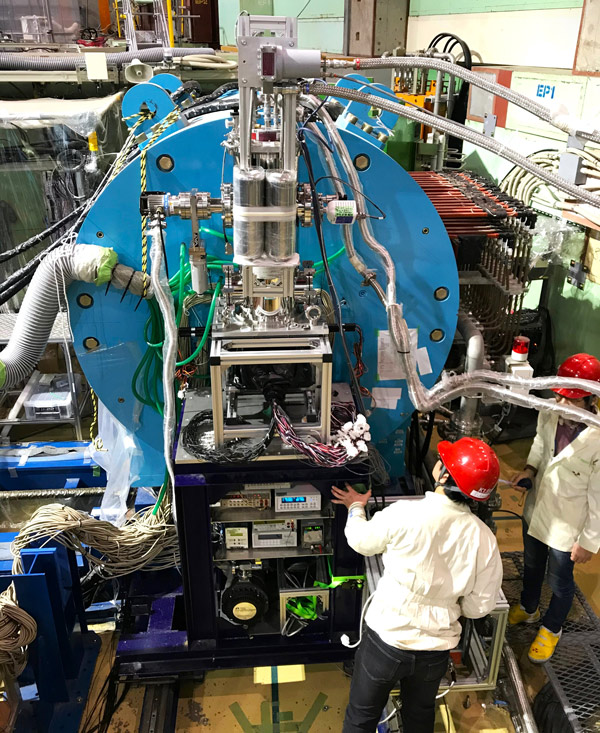Dec. 11, 2023 Research Highlight Physics / Astronomy
Measuring the lifetimes of strange nuclei
Nuclei with a property known as strangeness have been created and their lifetimes precisely determined

Figure 1: Two researchers working on the main detector used in their experiment. It is housed in the Hadron Hall at the J-PARC proton accelerator facility. © 2023 RIKEN Nishina Center for Accelerator-Based Science
RIKEN physicists have shown how hypernuclei—nuclei that contain exotic subatomic particles besides the protons and neutrons that make up normal atomic nuclei—can be generated and characterized1. This promises to extend our understanding of the fundamental nature of matter.
Quarks are the building blocks of matter. The standard model of elementary particles includes six of them with different flavors—up, down, charm, strange, top and bottom—along with their antiparticle equivalents.
The proton contains two up quarks and one down quark, while the neutron consists of one up quark and two down quarks.
However, other three-quark particles can be created by high-energy particle accelerators. For example, a hyperon has at least one strange quark combined with up and down quarks.
“Studying the interactions of hyperons with protons and neutrons advances our understanding of fundamental quark behavior and the strong nuclear force that binds them all together,” explains Yue Ma of the RIKEN Nishina Center for Accelerator-Based Science. “The study of hypernuclei is also valuable for exploring exotic forms of matter and understanding extreme environments in the Universe, such as in neutron stars.”
Working with an international team, Ma and his colleague Fuminori Sakuma have now demonstrated an innovative technique for producing hypernuclei through a process previously thought impossible.
At the J-PARC proton accelerator facility in Ibaraki prefecture, a beam of so-called kaons—a strange quark and an up antiquark—was collided with protons in helium nuclei.
They showed that the kaon could swap its strange quark with an up quark in the proton. This created a neutral pion and a so-called Λ-hyperon, consisting of up, down and strange quarks. The Λ-hyperon could then join with what was left of the helium nucleus, creating a hypernucleus made of a proton, two neutrons and the hyperon.
The team measured how long this exotic hypernucleus lived before it decayed, emitting a negatively charged pion in the process. But selecting this pion from all the others was not easy, and it required devising a new method.
“We’ve demonstrated for the first time that, by leveraging a relativistic effect known as the Lorentz boost, we can efficiently select the neutral pion and use it to identify Λ-hyperon production,” says Sakuma. “This breakthrough has opened new avenues in the field of hypernuclear physics.”
The team now aims to investigate another hypernucleus, the hypertriton: one proton, one neutron and one hyperon. Conflicting reports exist about the hypertriton’s lifetime, and the researchers hope their method will help to finally solve this puzzle.
Related content
- Gravitational waves could indicate transition to strange quark matter
- Exotic six-quark particle predicted by supercomputers
- Light nucleus predicted to be stable despite having two strange quarks
Rate this article
Reference
- 1. Akaishi, T., Asano, H., Chen, X., Clozza, A., Curceanu, C., Del Grande, R., Guaraldo, C., Han, C., Hashimoto, T., Iliescu, M. et al. Precise lifetime measurement of 4ΛH hypernucleus using in-flight 4He(K−, π0) 4ΛH reaction. Physics Letters B 845, 138128 (2023). doi: 10.1016/j.physletb.2023.138128
